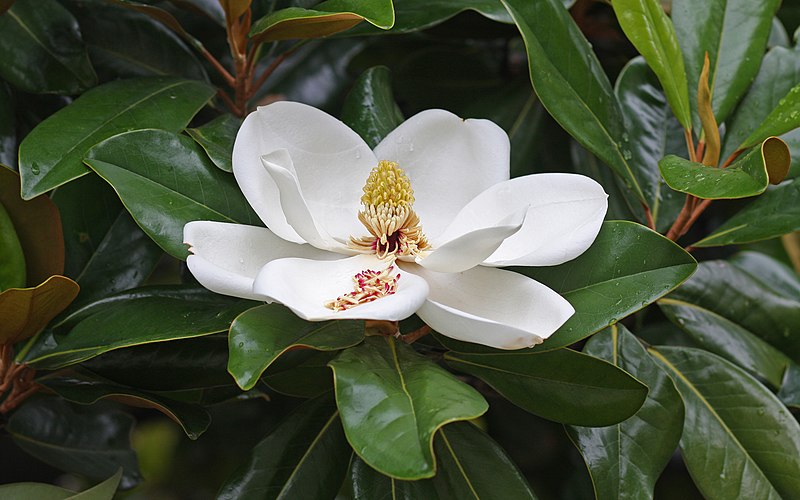
The flower of the Southern Magnolia (Magnolia grandiflora). The Magnolias lend their name to the scientific name of the division of flowering plants in general and also to the entire class of dicots!
Today I present for you a taxonomical break-down of a class of plants, the Dicots, which, along with Monocots, make up the phylum or division of flowering plants, the Angiosperms. Certainly even the casual botanist will recognize a great many names in the following list. I begin with identifying the class within the larger taxonomical structure, and then proceed to the parts of the Dicots, the Class Magnoliopsida. I also include a common name for each family, along with the occasion common name of a species in the family aside from that implied by the common name of the family itself. Please note that this list is not exhaustive. Enjoy!
Kingdom Plantae
Subkingdom Tracheobionta [Vascular Plants]
Superdivision Spermatophyta [Seed Plants]
DIVISION MAGNOLIOPHYTA [Flowering Plants]
Class
Magnoliopsida [Dicots]
·
Subclass
Asteridae
o
Order Asterales
§ Family Asteraceae [Aster family; composites]
o
Order Dipsacales
§ Family Caprifoliaceae [Honeysuckle family]
§ Family Dipsacaceae [Teasel family]
o
Order Gentianales
§ Family Apocynaceae [Dogbane family]
§ Family Asclepiadaceae [Milkweed family]
o
Order Lamiales
§ Family Lamiaceae [Mint family; basil, oregano]
o
Order
Plantaginales
§ Family Plantaginaceae [Plantain family]
o
Order Rubiales
§ Family Rubiaceae [Madder Family; coffee]
o
Order
Scrophulariales
§ Family Bignoniaceae [Trumpet-Creeper family; catalpa]
§ Family Oleaceae [Olive family; ash]
o
Order Solanales
§ Family Polemoniaceae [Phlox family]
§ Family Solanaceae [Potato family; nightshade,
tomatoes, tobacco, bell peppers]
·
Subclass
Caryophyllidae
o
Order
Caryophyllales
§ Family Cactaceae [Cactus family]
§ Family Caryophyllaceae [Pink family; carnations]
§ Family Phytolaccaceae [Pokeweed family]
·
Subclass
Dilleniidae
o
Order Capparales
§ Family Brassicaceae [Mustard family; cabbage,
broccoli, turnip]
o
Order Ericales
§ Family Ericaceae [Heath family; rhododendron, mountain
laurel]
o
Order Nepenthales
§ Family Droseraceae [Sundew family; venus fly-trap]
§ Family Sarraceniaceae [Pitcher-plant family]
o
Order Salicales
§ Family Salicaceae [Willow
o
Order Theales
§ Family Theaceae [Tea family]
o
Order Violales
§ Family Cucurbitaceae [Cucumber family; squash]
§ Family Violaceae [Violet family]
·
Subclass
Hamamelididae
o
Order Fagales
§ Family Betulaceae [Birch family; hazelnut, alder]
§ Family Fagaceae [Beech family; beech, chestnut, oak]
o
Order
Hamamelidales
§ Family Hamamelidaceae [Witch-hazel family; sweetgum]
§ Family Platanaceae [Plane-tree family; sycamore]
o
Order Juglandales
§ Family Juglandaceae [Walnut family; walnuts, hickory]
o
Order Urticales
§ Family Moraceae [Mulberry family]
§ Family Ulmaceae [Elm family]
·
Subclass
Magnoliidae
o
Order Laurales
§ Family Lauraceae [Laurel
o
Order Magnoliales
§ Family Annonaceae [Custard-apple family; pawpaw]
§ Family Magnoliaceae [Magnolia family; yellow poplar]
o
Order Piperales
§ Family Piperaceae [Pepper family]
·
Subclass Rosidae
o
Order Apiales
§ Family Apiaceae [Carrot family; celery, Queen Anne’s
Lace]
§ Family Araliaceae [Ginseng family; Hercules-club]
o
Order Celastrales
§ Family Aquifoliaceae [Holly family]
o
Order Cornales
§ Family Cornaceae [Dogwood family]
o
Order Fabales
§ Family Fabaceae [Pea family; legumes]
o
Order Geraniales
§ Family Balsaminaceae [Touch-me-not family]
§ Family Geraniaceae [Geranium family]
o
Order Rhamnales
§ Family Vitaceae [Grape family]
o
Order Rosales
§ Family Crassulaceae [Stonecrop family; jade plant]
§ Family Hydrangeaceae [Hydrangea family]
§ Family Rosaceae [Rose family; apples, peaches]
o
Order Sapindales
§ Family Aceraceae [Maple family]
§ Family Anacardiaceae [Sumac family; poison-ivy]
§ Family Hippocastanaceae [Horse-chestnut family;
buckeyes]
§ Family Meliaceae [Mahogany family]
§ Family Rutaceae [Rue family; citrus fruits, i.e.,
oranges, lemons]
§ Family Simaroubaceae [Quassia family; ailanthus]
Nota bene: taxonomy is always a matter of debate and
discussion – you may find different arrangements than those listed here.
Source: United States Department of Agriculture:
http://plants.usda.gov/classification.htmlWe shall have revisit the subject tomorrow with the Monocots...
Live well!
No comments:
Post a Comment